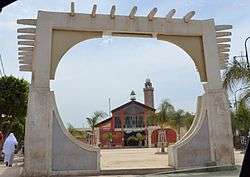Boudouaou
Boudouaou, during French colonialism known as L'Alma (or Alma) is a town in the western part of Boumerdès, Algeria. It is a coastal town on the Mediterranean Sea. Its population in 2008 was 56,398.[1]
Boudouaou | |
|---|---|
 | |
| Country | |
| Population (2008) | |
| • Total | 56,398 |
| Time zone | UTC+1 (CET) |
The original name is thought to be bou-dhou-aou, Arabic for illuminator in reference to a small insect the size of a beetle which at night shows beautiful brilliant green light in its tail.
Archaeology
The wilaya of Boumerdes represents an archaeological treasure by the multitude of historical sites that its vast territory of 1 456,16 km2 shelters.
Several prehistoric vestiges were discovered during the period of occupation. With the arrival of the colonizers and the project of colonization on the lands of Boudouaou, many prehistoric vestiges under the occupation were discovered: rhinoceros bones house in the Musée de l'Homme in Paris, a bronze axe, flint Retouched and prehistoric arrows are examples of discoveries already made.
Boudouaou is located on medium-altitude terrain that forms the current low Kabylie-Arabo-Musulmane, of which the town of Boumerdes is the chief town.
The mausoleum of Blad Guitoun, in the commune of Si Mustapha, is an illustrative example of the archaeological sites which were still apparent in low Arab-Muslim kabylie, at the beginning of the French colonization from 1837.
The Bénian ntâa Soumâa, in the commune of Thénia, is another archaeological site that had been marvelously preserved until the middle of the 19th century.
The Berber, Roman and Turkish Arab populations who lived around these archaeological sites before French colonization preserved this cultural and identity heritage.
The location of these archaeological sites on the banks and banks of Wadi Isser and Wadi Sébaou, as well as on the Mediterranean coast, makes it possible to classify the wilaya of Boumerdès among the rich archaeological niches in Algeria.
During the past centuries, the various floods and floods of the Wadi Isser and Wadi Sébaou (wadis of Lower Kabylie) caused the overflow of these rivers and buried the numid cities under the silt and the mud Carried by the torrents. Indeed, under a depth of about 3 meters, several discoveries in the wilaya of Boumerdès, of which numerous remains and archaeological sites, were uncovered in 2009.
In the village of Beni H'mida, in the commune of Leghata, retains a statue found alongside a metal dish, relics of pottery and human bones. A pitcher containing more than 900 silver coins engraved in the name of "Bolokine Abderrahmane", was discovered in Ouriacha village, in the commune of Naciria (Laâziv Zaâmoum).
In the village of Titouna of Souk El Had, a polished stone in the shape of a chest, engraved on its face with a metalworking scene, was also discovered at 3 meters underground during construction work, and was deposited at the level of The "wilayale" direction of culture in Boumerdès.[2]
Personalities
- Rachid Mimouni (An Algerian writer)
Politics
The town re-elected mayor Yahya Mahsas at the end of 2007 for 5 years, replaced by Mekki Hamoud in 2012.
Main cities
There are several villages in Boudouaou. The well known among them are:
- LACACE ar لاصاص
- BENADJAL ar بن عجال
- GHOUALEM ar الغوالم
- EL-NCHITE ar النشيط
- BEN MERZOUGA ar بن مرزوقة
- BEN YAMINA ar بن يامينة
References
- populstat.info Archived March 3, 2016, at the Wayback Machine
- http://www.djazairess.com/fr/infosoir/98613
.svg.png)